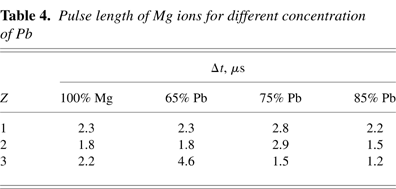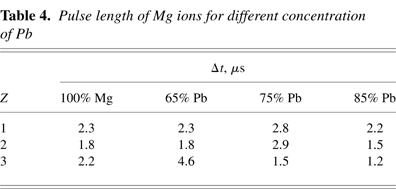Published online by Cambridge University Press: 05 December 2005
Characteristics of two-element (PbMg) laser generated plasma ions were studied using a mass-spectrometer. It was found that increasing the fraction of Mg leads to widening of the energy spectra of Pb ions by more than a factor of two, while the intensity of Pb ions of all charge states does not depend on the Mg fraction. This effect is explained by the friction existing between light and heavy ions during their expansion away from the target.
Inertial confinement fusion (ICF) is one of the promising approaches toward the realization of controlled thermonuclear fusion reactors (Hora, 2004). To achieve ignition of an ICF pellet, it needs to be compressed by more than a thousand times and at peak compression, heat at least a critical portion of it to a temperature exceeding 6 keV (Mulser & Bauer, 2004). A heavy ion fusion (HIF) scenario employs very intense heavy ion beams, which can deliver energy of several megajoules to a fusion target during a time of about 10 ns (Tahir et al., 2004). One of the main problems facing HIF is to find a source of ions with characteristics suitable for ICF (Ogawa et al., 2003; Hasegawa et al., 2000; Sharkov et al., 1998; Gushenets et al., 2003). It is well known that a laser source of ions can provide the highest intensity of multiply charged ions for injection into practically any accelerator (Dubenkov et al., 1996; Breschi et al., 2004). For practical use of these sources it is desirable to have high momentum without reduction in intensity and charge of ions. One of the ways to increase the momentum of ions is to use multi-element targets. It was demonstrated that the energy spectra of ions obtained by laser irradiation of multi-element targets appreciably differ from the spectra of ions obtained from single element targets (Doria et al., 2004; Ying et al., 2003; Rosmej et al., 2002; Rafique et al., 2005; Semerok et al., 2002; Osman et al., 2004; Rai et al., 2003; Bedilov et al., 1987, 1995; Bikovskie et al., 1977; Magunov et al., 2003). In the former case, the exchange of energy between ions of different mass is observed (the so called “ion friction effect”), which leads to the widening of energy spectra of both light and heavy ions.
In most of the experiments carried out so far, either targets consisting of only one element or targets consisting of fixed fraction of composing elements, that is, chemical compounds such as NaF, NaCl, NaBr, CuCl2, Cu Br2, PbCl2, and PbI2 were used (Sharkov et al., 1998). In this paper, properties of multiply charged ions formed under irradiation of PbMg targets with 15%, 25%, and 35% mass fraction n of Mg, respectively, are investigated. Since we use an amalgam of Pb and Mg, their relative fractions can be varied at will.
Experiments were carried out using a laser mass-spectrometer (see Fig. 1) with mass resolution of dm/m ∼ 0.01 and time-of-flight distance L = 100 cm. Detail description of the spectrometer can be found in Bedilov et al. (1987).

Experimental setup.
A Neodymium glass laser, in pulse mode, delivered pulses of 15 ns duration with peak power intensity around I = 5 × 1010 W/cm2 at the target at normal incidence. The peak power of the pulses varied within 5% and the data are averaged over five pulses. All experiments were carried out under the same conditions (vacuum 10−6 Tor). The construction of the target chamber allowed one to mount 10 targets with 10 mm diameter and change the location of laser incidence.
Experimentally observed mass-charge spectra of PbMg plasma ions for the different concentration of Mg shows that the plasma consists of Pb and Mg ions, and variation of n leads to variation of the composition of plasma and intensity of both kinds of ions emerging from the plasma. These variations are clearly seen for relatively low energy ions (E/Z ≤ 80 eV), as shown in Figures 2a and 2b for mono-(Pb) and two-component (PbMg) plasma (n = 35%).

Mass-charge spectra of plasma ions obtained from (a) Pb and (b) PbMg (n = 35%) targets at I = 5 × 1010 W/cm2.
It is seen from this figure that the inclusion of light element in the target leads to reduction of the charge of Pb ions and to the increase of the velocity of these ions. Experimental results also show that the maximum charge of ions of mono-element Pb plasma Zmax = 5, while the maximum charge of Pb (Mg) ions from two-element PbMg plasma is Zmax = 4. It is possible to detect Mg ions with maximum charge Zmax = 3 together with Pb ions with charge Zmax = 4 at the energy intervals 800–2500 eV for Pb ions and 250–800 eV for Mg ions. For relatively higher energies of ions (E ≤ 1000 eV) peaks of Mg ions disappears, and peaks of Pb ions are clearly seen.
Figure 3 shows the energy spectra obtained from mono-element targets consisting of Mg (a), Pb (b), and two component PbMg targets with n = 15% (c), 25% (d), and 35% (e), respectively. Ions from mono-element Pb and Mg targets have energies in the range of 150–1200 eV and 250–2000 eV with maximum charge Zmax = 4 and 5, respectively. In the case of the two-element targets Zmax with both kinds of ions is at least one unit lower. The energy spectra of Pb ions extend to ≥ 4000 eV, whereas the spectra of Mg ions shrink to ≤ 1000 eV. For any concentration of Mg, two groups of ions of different spectral range are clearly seen and with increasing n the energy spectra of Mg ions remains virtually unaltered while the spectra of Pb ions extends to higher energies. To our knowledge, the extension of energy spectra of two-element plasma ions in comparison with mono-element plasma is due to the change of recombination processes and this effect can be used to control the charge and intensity of the ions with a given charge.

The energy spectra of ions from mono Mg (a) and Pb (b), and two-element PbMg plasma for the concentration of Mg n = 15% (c), 25% (d), 35% (e).
The maximum Emax and minimum Emin energies and total number N (Nmax and Nmin is the maximal and minimal number of ions in the region which was taken to be constant for ions with given charge) of Pb ions with Z = 1–5 are given in Table 1 for different concentration of Mg. These results show that for Pb ions with Z = 1,3 Emax increases with increasing n, while ions with Z = 2,4 Emin increases up to n = 25% and thereafter decreases. For the Emin, we see a nonlinear dependency on n. Such a tendency was found for Mg ions as well (see Table 2).
The maximum and minimum energies of Pb ions with Z = 1–5 for different concentration of Mg

The maximum and minimum energies of Mg ions for different concentration of Pb

The pulse duration of Pb and Mg ions is shown in Tables 3 and 4 for different concentrations of Mg. It is seen that with increasing fractional concentration of Mg the pulse length increases.
Pulse length of Pb ions for different concentration of Mg

Pulse length of Mg ions for different concentration of Pb

Figure 4 shows the total number of Pb ions as a function Mg fraction n. It is seen that the intensity of Pb ions with charge Z ≤ 3 increases with increasing n, while the intensity of Pb ions with charge Z = 4 is independent of n.

Total number of Pb ions N as a function of Mg fraction n.
The extension of energy spectra to higher energies and the presence of a maximum in the spectra (see Fig. 3) show that, processes in two-component targets subjected to laser irradiation occur in two stages. In the first stage (up to the maximum of the pulse) intense ionization takes place entailing the increase of multiply charged Mg and Pb ions. The second phase (after the maximum) is characterized with the increase of recombination processes, that is, with energy exchange between light (Mg) and heavy (Pb) ions of plasma.
Results presented in this paper permit us to conclude that the formation of charge and energy spectra of multiply charged ions in two-element PbMg plasma is defined not only by the ionization and recombination processes, but also by the mutual interaction of ions of different species in the plasma. Furthermore, the results can be explained by assuming the flow velocity of the plasma away from the target is determined by the average ion mass defined as

where, mPb and mMg are masses of Pb and Mg ions and nPb and nMg are their number densities, respectively. The observed energy and charge spectra are a consequence of the interplay between plasma life time and the ionization/recombination time scales of various ion species (Bikovskie et al., 1977). For example, in order to obtain ions of charge state Z, it is necessary that the condition Ti(Z)<T0<Tr(Z) is fulfilled, where Ti(Z) is the time scale for the production of charge state Z, T0 is the plasma life time, and Tr(Z) is the time scale for the destruction of charge state Z. Note that these time scales can be controlled by varying the composition of the target.
We have investigated the interaction of laser radiation with two-element PbMg targets and the formation of charge and energy spectra of multiply charged ions for different relative fractions of the target components. The experiments show that, due to exchange of energy between light and heavy ions, with increasing fraction of Mg, the maximum energy of the Pb ions spectrum extends to twice that of the one obtained with pure Pb targets alone. The intensity of Pb ions increases with increasing concentration of Mg, due to the reduction of the effective ion mass.
This work has been supported by DAAD and by IAEA. Khaydarov likes to acknowledge fruitful discussions and the kind hospitality of D.H.H Hoffmann and his Plasma Physics research group at GSI during two research stays, during which this work was prepared.

Experimental setup.

Mass-charge spectra of plasma ions obtained from (a) Pb and (b) PbMg (n = 35%) targets at I = 5 × 1010 W/cm2.

The energy spectra of ions from mono Mg (a) and Pb (b), and two-element PbMg plasma for the concentration of Mg n = 15% (c), 25% (d), 35% (e).

The maximum and minimum energies of Pb ions with Z = 1–5 for different concentration of Mg

The maximum and minimum energies of Mg ions for different concentration of Pb

Pulse length of Pb ions for different concentration of Mg

Pulse length of Mg ions for different concentration of Pb

Total number of Pb ions N as a function of Mg fraction n.